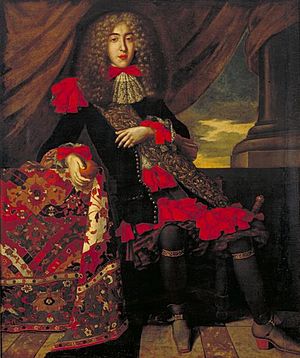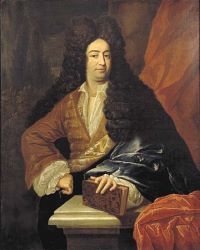Francisco Lopes Suasso facts for kids
Francisco Lopes Suasso, second Baron d'Avernas le Gras (born around 1657 – died April 22, 1710) was a very important banker and financier in the Dutch Republic. He was also known as Abraham Israel Suasso within the Sephardic Jewish community.
Contents
A Family's Journey: From Spain to Amsterdam
After being forced to leave the Iberian Peninsula (modern-day Spain and Portugal), many Sephardi Jews settled in busy trading cities like London and Antwerp. By the late 1500s, they began arriving in Amsterdam and The Hague in the Netherlands.
The Lopes Suassos were a wealthy and old Sephardic family. They were known as Marranos, which meant they had been forced to convert to Christianity during the Portuguese Inquisition. But once they arrived in Amsterdam, they were free to openly return to their true religion, Judaism.
Francisco's Early Life
Francisco Suasso was born in Amsterdam. He was the oldest son of Antonio Lopes Suasso (1614–1685), who was also a famous banker. Antonio was known as Isaac Israel Suasso. Francisco's mother was Violenta de Pinto, who came from another rich Sephardic family.
His father, Antonio, was born in Bordeaux, France. He became one of the wealthiest and most well-known Portuguese-Jewish merchants and bankers in Amsterdam. Francisco was likely born between 1657 and 1660. He had four sisters and a younger brother who died young.
A Noble Title and Royal Connections
The Suasso family always felt a connection to Spain. On January 3, 1676, Francisco's father received a special title from Charles II of Spain. He became the Baron d'Avernas le Gras because of his help with diplomatic matters. This title came from a large estate the Suassos owned in a region called the Duchy of Brabant.
The family also had a good relationship with the Stadtholders, who were like governors of the Dutch provinces. The Suasso banking house often helped them with money.
Francisco's Banking Career and Family Life
Francisco joined his father's banking business. When his father passed away in 1685, Francisco inherited half of his large fortune. Much of this money was in shares of the Dutch East India Company, a very powerful trading company. He continued to be a very successful banker.
First Marriage and a Big Loan
In 1682, Francisco married Judith Francisco Teixeira in Hamburg. She was the daughter of Manuel Teixeira, another important Portuguese-Jewish banker. In those days, marriages often helped families gain more wealth and power. However, Judith died in 1689 without having any children.
One famous story shows how much the Suasso family supported the Dutch leaders. In 1688, Francisco lent two million guilders to William of Orange. This huge loan helped William invade England in what was called the Glorious Revolution. He wanted to claim the throne from King James II.
The story goes that William asked Suasso what he wanted as a guarantee for the money. Suasso supposedly replied: "If you succeed, I know you will pay me back. If you don't succeed, I agree to have lost the money." This story might not be entirely true, but it shows his trust in William.
Suasso helped with many parts of the invasion. Through his father-in-law in Hamburg, he quickly arranged for Swedish troops to be transported to help William. Today, the special box where William repaid the loan to Suasso is on display in the Willet-Holthuisen Museum in Amsterdam.
Second Marriage and Many Children
After his first wife died, Francisco married Leonora (also known as Rachel) da Costa on February 23, 1694, in The Hague. They had ten children together, creating a large family network.
Their seven sons were Antonio (1695–1775), Alvaro (1696–1751), Manuel (1698–1773), Pedro (1700–1742), Jeronimo (1702–1740), David (1703–1705), and Francisco (1710–1770). Their three daughters were Leonora (1701–1754), Sara (1706–1767), and Hanna (1708–1721).
Later Life and Legacy
Francisco Suasso passed away in The Hague on April 22, 1710, when he was in his early fifties. He was buried in the Portuguese-Jewish cemetery called Ets Haim in Ouderkerk aan de Amstel. His oldest son, Antonio Lopes Suasso the Younger, took over his banking business and the title of Baron d'Avernas le Gras.
Images for kids
-
Portrait of Francisco Lopes Suasso, by Nicolaes Maes




